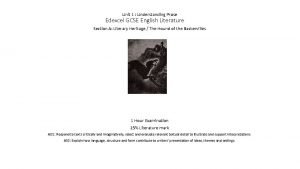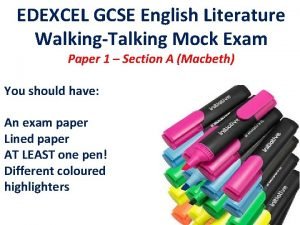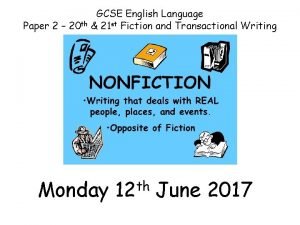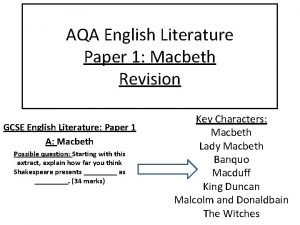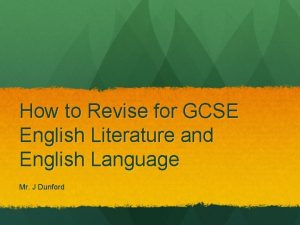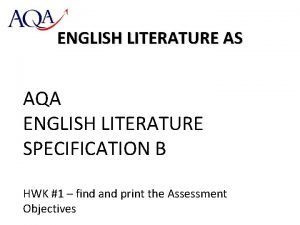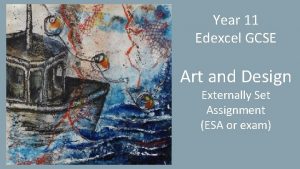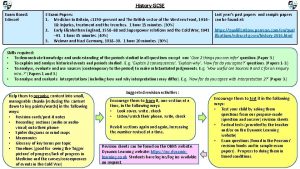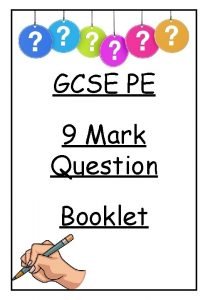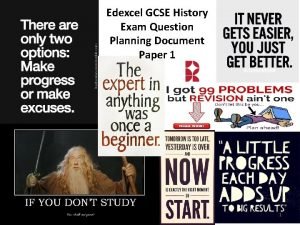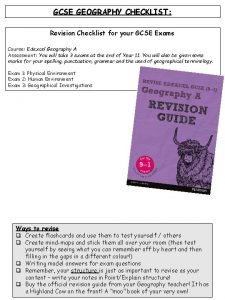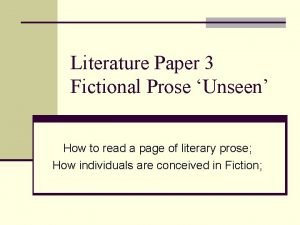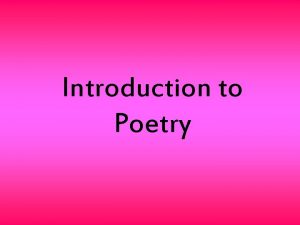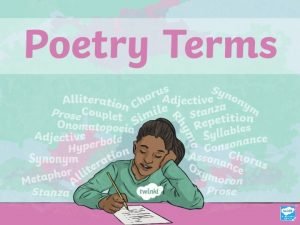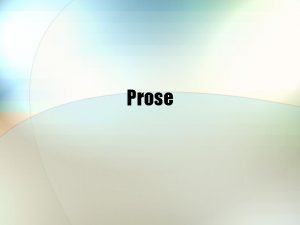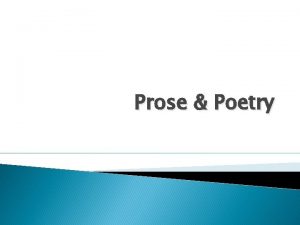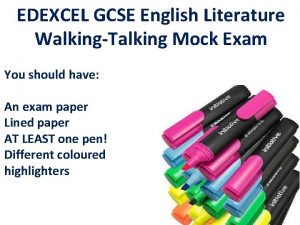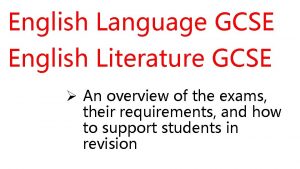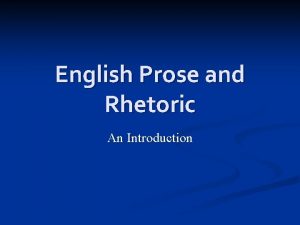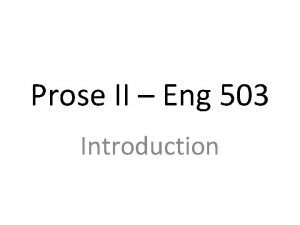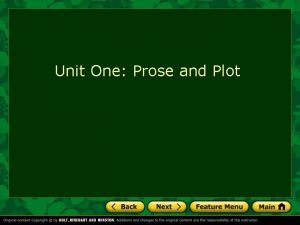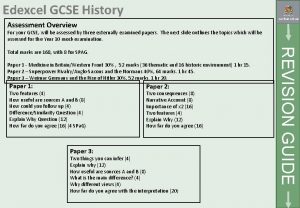Unit 1 Understanding Prose Edexcel GCSE English Literature
























- Slides: 24

Unit 1 : Understanding Prose Edexcel GCSE English Literature Section A: Literary Heritage / The Hound of the Baskervilles 1 Hour Examination 25% Literature mark AO 1: Respond to texts critically and imaginatively; select and evaluate relevant textual detail to illustrate and support interpretations. A 02: Explain how language, structure and form contribute to writers’ presentation of ideas, themes and settings.

The Hound of the Baskervilles- Plot Summary • Sherlock Holmes and Watson are visited by Dr James Mortimer who tells them about Hugo Baskerville and the legend of the hound and the recent death of Sir Charles Baskerville. • Holmes and Watson meet Henry Baskerville, discover he’s received a warning letter and realise that while in London he is being followed. • Holmes sends Watson with Henry Baskerville to Dartmoor. • When they arrive at Baskerville Hall they discover a convicted murderer, Selden, has escaped from prison and is loose on the Moor. • Watson meets Mr Stapleton, who is very familiar with the moor, and his sister. She mistakes him for Sir Henry and warns him to return to London. • In the night, Watson sees Barrymore ( the butler at Baskerville Hall) signalling out of the window with a candle. • Stapleton is very angry when he discovers Henry Baskerville’s affections towards his sister. • Watson and Henry confront Barrymore about the signal at the window and he confesses to having left food for the escaped convict Selden, who is in fact his wife’s brother. • Watson and Henry decide to try to capture Selden, but see another figure on the moor in the night. • Barrymore also reveals that on the night of Sir Charles's death, he had gone to meet a woman with the initials L. L. They further discover she is Laura Lyons who was hoping Sir Charles could help her pay for her divorce from a husband who has abandoned her. • Watson discovers that Holmes has been hiding on the moor, conducting his own investigations, all along! • Holmes has discovered Miss Stapleton is Mr Stapleton’s wife and not his sister. Also, Mr Stapleton has been misleading Laura Lyons about the possibility of marrying him. • Holmes and Watson hear the hound and find Selden, dressed in Henry’s clothes, dead having fallen to his death. • At Baskerville Hall, Holmes realises there is a family connection between Hugo Baskerville and Stapleton, so his motivation is to inherit the Baskerville fortune. • Leading everyone to believe he is returning to London, Holmes tells Henry to have dinner with the Stapleton’s that evening and then walk home across the moor. • Holmes and Watson question Laura Lyons again, reveal Stapleton’s deception, and discover it was Stapleton whotold her to lure Sir Charles into the garden on the night of his death. • That evening, Holmes, Watson and Lestrade , a police Inspector from London, wait outside Stapleton’s house for sir Henry. They see Stapleton open up an outhouse in the garden and when Henry leaves he is attacked by a gigantic hound. The hound is shot and Henry saved. The hound had been painted with phosphorus to glow in the dark. • Stapleton is perused onto the moor, but dies when he sinks into Grimpen Mire in the fog.

The Exam • You will be given a short extract from the novel (250 -350 words). You will also have a clean copy of the text. • You will have one hour to answer three question. • Question A: 8 marks / 15 minutes- In this extract, what do you learn about the character…? • Question B: 12 marks / 20 minutes – Explore how the writer uses language in the extract to… • Question C: 16 marks / 25 minutes- theme. Explore how the writer presents (theme) in one other part of the novel. • SPG- 3 Marks

QA QC QB

Question A: Know your characters! Has a deep sense of duty and responsibility. Sherlock Holmes is… Has unusual and unpredictable habits Is secretive Depends on and trusts Watson Uses Watson as his foil (foil is a character who contrasts with another character – usually the protagonist- in order to highlight particular qualities of the other character) and enjoys outwitting him. Sharp powers of observation Unusually intelligent Uses scientific methods and inference & deduction based on evidence Disbelieves anything supernatural Asks probing and insightful questions Famous and well known but doesn’t care about fame Bursts of enthusiasm and passion Capable of convincing disguise and deception ‘Amature’ detective who solves crimes for and is admired by the police (Lestrade) Can become totally absorbed in a case at the expense of his health / comfort. At times blunt and insensitive to others’ feelings Enjoys feeling superior and outwitting others Tenacious and doesn’t give up Enjoys a challenge and a fitting opponent Can be a man of action and adventure Is the dominant figure in the relationship with Watson Has particular habits- coffee and strong tobacco when thinking

• Dr Watson is… • • • Often surprised by Holme’s amazing talents Attempts to follow Holme’s methods but fails Admires, trusts and respects Holmes Loyal Reliable Kind Follows Holmes’s instructions Can be hurt by Holmes- wounded pride and feel slighted Army- man of action / adventure Reports events faithfully • Sir Henry Baskerville is… • • • Sometime pugnacious and ready to fight / argue Hot headed descendent of Hugo Baskerville Strong and physically sturdy Confident and self assured Decisive and authoritative Blunt and straightforward Feels and sense of roots, belonging and family history Vulnerable to the superstition of the Hound- becomes scared Trusts Holmes and Watson Gentleman of status Alert and intelligent Kind / Forgiving

• Dr Mortimer is… • • Old fashioned doctor Dignified and solid Kind Intelligent Very enthusiastic about science Unintentionally honest / rude Feels a loyalty to the Baskerville family Believes in science but shaken my the mysterious events • Sir Charles Baskerville was… • • Kind and generous Private A man of habits Limited needs (small household / simple tastes) Wealthy and investing in the local area Shaken by legend of Hound Heart condition and suffering stress and ill health Well-liked by friends and staff

• Stapleton is… • • • • • Wily and cunning A match for Holmes Capable of disguise Methodical in planning and preparation Deeply intelligent Violent and capable of anger Witty and enjoys his crimes Cold and ruthless Admired by Holmes Speaks ironically Uses questioning to dig up information Manipulates others by befriending them Fit, active and strong Knows the moor Botany & Zoology Dominates and intimidates wife Duplicitous and deceives others • Miss Stapleton is… • • Beautiful Looks / sounds Spanish / South American Afraid and intimidated by her ‘brother’ Forced into colluding with his crimes Takes risks to stop him Passionate and fiery temper Capable of deception

Barrymore and Mrs Barrymore • How well do you know the text? • Can you find the relevant extracts covering these two characters and make a list of their main features? Tip: P 60, 63 -63, 81 -83, 90 -94, 101104, 108 -109. • Barrymore Mrs Barrymore Do the same for Laura Lyons / Frankland- minor characters, but you never know!

LO: Understand how character is revealed by the author and the techniques he uses. QA On page 91 -92, what do you learn about the character Barrymore? What others say about the character The way others behave around them How the character moves Their actions Name What the character says How the character speaks Physical characteristics

10 En 2 Super Answer! The combined efforts of the best of your groupwork. How do you answer QA? • • • 10 -15 min. 1 -2 sides A 4. Make 6 -8 different points about the character. Use more than one quote for each point- aim for 10 -15. Use short embedded quotes. Combine quick point and evidence in one sentence. • Select quotes from different parts of the text to support your points. • Look for layers of meaning and say more than one thing about a quote: “It also suggests that…” • Go beyond the obvious and keep your comments perceptive. • Comment on how the structure (AOI)of the text is used to reveal details about the character: “At the start of the extract…Further on…By the end…this links to…” • No language analysis! • This suggests…The reader will infer that…The inference here is that…The reader will deduce… At the start we learn Homes is a creature of habit who is “usually up very late in the morning” Not because he’s lazy, he’s often “up all night” because a particular case has intrigued and excited him and he wont rest until he has solved it, and cannot be deviated by comforts like rest and sleep. This suggests an antisocial character who works at night, in solitude, when he wont be disturbed. Perhaps he also uses the cover of night to secretly conduct his investigations. These investigations are conducted in detail, as Holmes’ attention to details is describes as ‘sharp’. He uses a ‘convex lens’ to study the stick suggesting he is paying attention to detail and doesn’t want anything to escape his careful attention. Later in the text his ‘method’ and ‘system’ are referred to, suggesting he has perfected his expertise in detective work, despite being an amateur. These methods can often be cunning and ingenious. He uses a ‘wellpolished coffee pot’ as a mirror to observe Watson which is very creative. We learn Holmes can be rude and sarcastic as in the middle of the text he cries “Good!” and “Excellent” in response to Watsons ideas, however at the end he says all Watson’s observations were “erroneous” and wrong. This perhaps shows a cruel side to his character as he has been toying with Watson, knowing he’s make mistakes. Or maybe it’s accidental as he doesn’t appreciate other people’s feelings. Holmes’ uses irony and sarcasm to increase his ego, he seems to enjoy showing he’s more intelligent that other people. Also, although he’s toyed with Watson we also see his softer side when he calls his friend “My dear Watson” showing affection and respect. It’s a rather paradoxical relationship at times. Despite any insult Holmes gives, Watson admires Holmes and wants to impress him by learning and using his ‘system’ and is glad when he seems to get ‘his approval. ’ He has great regard for Holmes’ work and has tried to make him famous. Although proud of his intelligent he’s also modest and avoids public fame as he is uninterested in Watson’s “attempts… to give publicity. ” Task: annotate this answer to show why it would get full marks.

Question B : Know your language terms Nouns Adjective Simile / Metaphor Verbs (imperative) Alliteration/Sibilance Adverbs Imagery- (senses: visual, auditory, Prepositions kinaesthetic, auditory, olfactory) Onomatopoeia Pathetic fallacy Irony Hyperbole Personification Foil Repetition / pattern of three/ Listing Semantic field Contrast / Juxtaposition Genre- gothic Symbolism – colour

How to answer QB QB- Explore how the writer uses language to create e. g. a sense of excitement and adventure at the end of chapter 4. 1. Start by selecting a range of quotes which you think create a sense of excitement and adventure. A 02: Explain how language, structure and form contribute to writers’ presentation of ideas, themes and settings. • Challenge: Focus on structure. Structure= the shape and organisation of the content. • What effect does it have that information is where it is? • How does it start? What comes next? Is that important? • Is it linked to anything? • Is meaning being created within or between paragraphs? Are there contrasts or are similar ideas developed? • How does it end? What’s the effect? 2. Keep them short and focus precisely on the one or two words creating the effect. • Handy phrases: 3. Try to identify the language device using the correct language term. • …creates an important structural effect… • The structure is effective because • The text is organised in a way that 4. Explain in note form in your annotation how the e. g. sense of excitement/adventure is created. • Putting this description first/last/next 5. Use PETER and SWAT to develop your answers. • Between paragraphs • …is linked to … • …within the paragraph… • At the start / In the second/third paragraph…But then at the end/in the next paragraph

Identifying Grammatical Features • Sentence Structure • Short / Emphatic: That’s not it. Typically create pace and drama. • Long Sentences: Typically create anticipation or build up detail. • Contrasting sentence lengths. • Compound- and, but, or. • Complex: a main and subordinate clause: When he arrived the gates were shut. • Subordinate Clause: When he arrived the gates, which were rusty and broken, were shut. • Exclamation: Stop! • Question / Rhetorical- asked/ for effect: What are you doing? Do you wish things were different? • Ellipsis: The door opened…but no one was there. • Parenthesis: a word or phrase inserted as an explanation or afterthought into a passage, usually marked off by brackets, dashes, or commas. • Repetition: • Sentence opening: Adverbs like ‘Suddenly’. • Passive voice (active: The dog bit the boy. Passive: The boy was bitten by the dog. Note that the emphasis is on the person affected by the verb)

QB: Explore how the writer uses language to present Miss Stapleton. I was standing watching his pursuit with a mixture of admiration for his extraordinary activity and fear lest he should lose his footing in the treacherous mire, when I heard the sound of steps and, turning round, found a woman near me upon the path. She had come from the direction in which the plume of smoke indicated the position of Merripit House, but the dip of the moor had hid her until she was quite close. I could not doubt that this was the Miss Stapleton of whom I had been told, since ladies of any sort must be few upon the moor, and I remembered that I had heard someone describe her as being a beauty. The woman who approached me was certainly that, and of a most uncommon type. There could not have been a greater contrast between brother and sister, for Stapleton was neutral tinted, with light hair and gray eyes, while she was darker than any brunette whom I have seen in England—slim, elegant, and tall. She had a proud, finely cut face, so regular that it might have seemed impassive were it not for the sensitive mouth and the beautiful dark, eager eyes. With her perfect figure and elegant dress she was, indeed, a strange apparition upon a lonely moorland path. Her eyes were on her brother as I turned, and then she quickened her pace towards me. I had raised my hat and was about to make some explanatory remark when her own words turned all my thoughts into a new channel. "Go back!" she said. "Go straight back to London, instantly. " I could only stare at her in stupid surprise. Her eyes blazed at me, and she tapped the ground impatiently with her foot. "Why should I go back? " I asked. "I cannot explain. " She spoke in a low, eager voice, with a curious lisp in her utterance. "But for God's sake do what I ask you. Go back and never set foot upon the moor again. " "But I have only just come. " "Man, man!" she cried. "Can you not tell when a warning is for your own good? Go back to London! Start tonight! Get away from this place at all costs! Hush, my brother is coming! Not a word of what I have said. Would you mind getting that orchid for me among the mare's-tails yonder? We are very rich in orchids on the moor, though, of course, you are rather late to see the beauties of the place. " Stapleton had abandoned the chase and came back to us breathing hard and flushed with his exertions. "Halloa, Beryl!" said he, and it seemed to me that the tone of his greeting was not altogether a cordial one. "Well, Jack, you are very hot. " "Yes, I was chasing a Cyclopides. He is very rare and seldom found in the late autumn. What a pity that I should have missed him!" He spoke unconcernedly, but his small light eyes glanced incessantly from the girl to me. "You have introduced yourselves, I can see. " "Yes. I was telling Sir Henry that it was rather late for him to see the true beauties of the moor. " "Why, who do you think this is? " "I imagine that it must be Sir Henry Baskerville. " "No, no, " said I. "Only a humble commoner, but his friend. My name is Dr. Watson. " A flush of vexation passed over her expressive face. "We have been talking at cross purposes, " said she. "Why, you had not very much time for talk, " her brother remarked with the same questioning eyes. "I talked as if Dr. Watson were a resident instead of being merely a visitor, " said she. "It cannot much matter to him whether it is early or late for the orchids. But you will come on, will you not, and see Merripit House? "

• Question C: 16 marks = 3 SPG / 25 minutes. • Explore how the writer presents (theme/setting/character/relationship) in one other part of the novel. Question C: Know your themes and extracts Setting: Moor Arrival 55 -57, Stapleton/pony 67 -70, site of hugo 77 -78, Dr W’s desc 105 -106, Ending 149 -151 Setting: Baskerville Hall Outside 58 -59 , Inside 60 -62 Secrecy / Deception Miss S 71 -75 , Stapleton & Dr W 65 -70, Stapleton finds Selden 131 -135, Barrymore 90 -94 Fear Sir C 19 -21 , Moor/Selden 56 -58, Stapleton & Pony 69 -70, Selden & Hound 95 -96, End 147 -152 Supernatural Legend 19 -21 & 23 -25 Truth Barrymore light 90 -94, Holmes on moor 121 -125, Portrait 138 -140, Laura L 142 -145 Relationship H+W Opening 5 -7, Send Dr W to Dart 47 -48, meet on moor 121 -124 Relationship Barrymore & Henry B Barrymore Light 90 -94 , Selden argue & LL reveal 101 -104 Mystery Letter & boots 31 -36, Miss S 71 -75, Barrymore 90 -94, End 147 -152 Danger Sir Hugo 13 -15, Man on Moor 119 -121, Selden & Hound 95 -96, End 147 -152 Adventure Chase 38 -40, Selden hunt & Hound 95 -96, Selden death 127 -130, End 147 -152 Investigation / Detection Stick 5 -9, Map 27 -30, Letter 31 -36 Key Extracts Barrymore light 90 -94, Ending 147 -152, Selden hunt & Hound 95 -96, Holmes on Moor 119 --126

(a) From the extract, what do you discover about the character Sir Charles? Use evidence from the extract to support your answer. 8 Marks / 15 Min (b) Explore how the writer uses language in the extract to create a sense of danger. 12 Marks / 20 Min (c) In the extract the writer presents the idea of the effect of the legend of the Hound on Sir Charles. Explore how the writer presents the idea of the effect of the legend of the Hound in one other part of the novel. 16 Marks / 25 Min

June 2014 (a) From the extract, what do you discover about the character Sir Henry? Use evidence from the extract to support your answer. 8 Marks / 15 Min (b) Explore how the writer uses language in the extract to create a sense of secrecy. 12 Marks / 20 Min (c) In the extract Barrymore attempts to hide something and deceive Sir Henry and Watson. Explore how the writer presents the idea of disguise and deception in one other part of the novel. 16 Marks / 25 Min

June 2013 QA: What do you learn about the character of Sir Henry? QB: Explore how the writer uses language to present theme of fear. QC: In the extract the writer presents a scene of adventure. Explore how the writer presents adventure in one other part of the novel.

Jan 2012 (a) From the extract, what do you discover about the character Watson? Use evidence from the extract to support your answer. 8 Marks / 15 Min (b) Explore how the writer uses language in the extract To present the relationship between Holmes and Watson. 12 Marks / 20 Min (c) Explore how the writer presents the relationship between Holmes and Watson in one other part of the novel. 16 Marks / 25 Min

June 2011 (a) From the extract, what do you discover about the character Miss Stapleton? Use evidence from the extract to support your answer. 8 Marks / 15 Min (b) Explore how the writer uses language in the extract to create a sense of mystery. 12 Marks / 20 Min (c) Explore how the writer presents the idea of mystery in one other part of the novel. 16 Marks / 25 Min

A) What do you learn about the character Watson? B) Explore how the writer uses language to present the relationship between Holmes and Watson. C) In this extract the truth about the man on the moor is revealed. Explore how the truth about another mystery is revealed in One other part of the text.

(a) From the extract, what do you discover about the character Stapleton? Use evidence from the extract to support your answer. 8 Marks / 15 Min (b) Explore how the writer uses language in the extract to present the Moor. 12 Marks / 20 Min (c) In the Moor is presented as a dangerous place. Explore how the writer presents the idea of the Moor in one other part of the novel. 16 Marks / 25 Min

Create Your Own Exam Paper • Page/s • Question A: In this extract, what do you learn about the character………………………. . ? • Question B: Explore how the writer uses language in the extract to…………………………………. . . • Question C: In this extract……………… ……. Explore how the writer presents……………………………………………………. . in one other part of the novel.
 Edexcel gcse english literature
Edexcel gcse english literature English literature paper 1 past papers
English literature paper 1 past papers Edexcel macbeth extract questions
Edexcel macbeth extract questions English language paper 2 edexcel
English language paper 2 edexcel English language gcse edexcel
English language gcse edexcel English language paper 2 transactional writing
English language paper 2 transactional writing Pearson edexcel international gcse english anthology
Pearson edexcel international gcse english anthology Ocr english literature gcse
Ocr english literature gcse English language paper 1 macbeth
English language paper 1 macbeth Wjec eduqas gcse poetry anthology
Wjec eduqas gcse poetry anthology How to revise english literature
How to revise english literature Aqa english literature specification
Aqa english literature specification Gcse art assessment objectives edexcel
Gcse art assessment objectives edexcel Pie chart gcse questions and answers
Pie chart gcse questions and answers History gcse edexcel past papers
History gcse edexcel past papers Gcse pe 9 marker
Gcse pe 9 marker Music gcse edexcel past papers
Music gcse edexcel past papers Music edexcel gcse
Music edexcel gcse Edexcel gcse drama
Edexcel gcse drama Edexcel gcse pe specification
Edexcel gcse pe specification Edexcel gcse history crime and punishment past papers
Edexcel gcse history crime and punishment past papers Gcse geography edexcel b revision checklist
Gcse geography edexcel b revision checklist The unseen enemy thematic concept
The unseen enemy thematic concept Prose vs poetry
Prose vs poetry Prose in literature
Prose in literature
